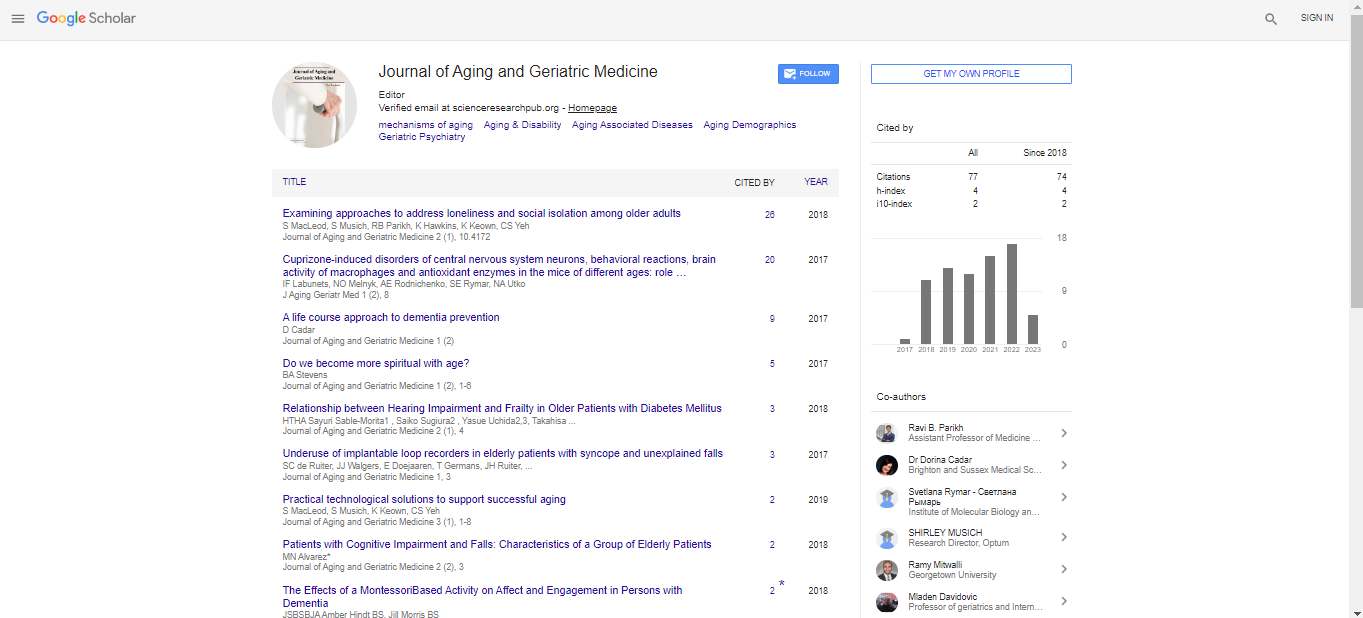Perspective, J Aging Geriatr Med Vol: 7 Issue: 4
Transformative Potential of Environmental Geriatrics in Gerontology and Public Policy
Simone Wallane*
1Department of Medicine, University of Louisville, Louisville, United States of America
*Corresponding Author: Simone Wallane,
Department of Medicine, University of
Louisville, Louisville, United States of America
E-mail: wallanes@uc.edu
Received date: 28 June, 2023, Manuscript No. AGM-23-113311;
Editor assigned date: 30 June, 2023, PreQC No. AGM-23-113311 (PQ);
Reviewed date: 14 July, 2023, QC No. AGM-23-113311;
Revised date: 21 July, 2023, Manuscript No. AGM-23-113311 (R);
Published date: 28 July, 2023, DOI: 10.4172/2576-3946.1000165
Citation: Wallane S (2023) Transformative Potential of Environmental Geriatrics in Gerontology and Public Policy. J Aging Geriatr Med 7:4
Description
Environmental geriatrics focuses on the profound influence of the physical and social environments on the well-being and quality of life of older adults. As the global population ages, the relationship between the environment and the health and well-being of older adults becomes increasingly important. Green spaces, including parks, gardens, and natural landscapes, play a vital role in enhancing the well-being of older adults and promoting healthy aging. Green spaces are essential components of urban and rural environments that offer numerous health benefits to individuals of all ages. Environmental geriatrics is a field that recognizes that the physical, social, and cultural environments profoundly affect the experiences of aging individuals. Age-friendly environments are designed to meet the unique needs and preferences of older adults, enabling them to live independently, engage in social activities, and maintain good health. Environmental Factors Impacting Aging Environmental geriatrics encompasses a wide range of factors that influence the health and quality of life of older adults.
Strategies for creating age-friendly environments
Creating age-friendly environments requires a concerted effort from policymakers, urban planners, healthcare providers, and communities. Several strategies can contribute to the development of age-friendly communities.
Urban planning and design: Implementing universal design principles to ensure buildings and public spaces are accessible to people of all ages and abilities. Reducing barriers to mobility, such as curbs and stairs, and improving lighting and signage.
Community engagement: Involving older adults in the planning and decision-making processes related to their communities. Encouraging intergenerational interactions and partnerships.
Healthcare and social services: Expanding access to healthcare services and home-based care for older adults. Promoting preventive health measures and wellness programs tailored to older individuals.
Public awareness and education: Raising awareness about the challenges faced by older adults and the importance of age-friendly environments. Educating individuals and communities about ageism and the benefits of intergenerational interactions.
Applications
Age-friendly communities: Designing and modifying communities to be more age-friendly. This includes creating walkable neighborhoods, accessible public transportation, and recreational spaces that cater to the needs of older adults.
Housing adaptations: Assessing and retrofitting housing to make it safer and more accessible for older adults. This may involve installing grab bars, ramps, wider doorways, and improved lighting. Integrating technology into homes to assist older adults with daily living tasks, monitor their health, and provide emergency assistance when needed.
Dementia-friendly environments: Creating environments that are supportive of individuals with dementia. This includes minimizing confusing signage, reducing noise, and providing secure outdoor spaces.
Long-term care facilities: Designing nursing homes and assisted living facilities with a focus on resident comfort, safety, and quality of life. This includes creating spaces for social interaction and recreation. Informing public health policies and urban planning to account for the needs of an aging population. This might involve zoning laws, transportation policies, and healthcare access.
Outdoor spaces: Developing and maintaining parks and green spaces that are accessible and inviting to older adults. These spaces can promote physical activity and social engagement. Providing resources and support to family caregivers who may be dealing with the challenges of caregiving within a home environment.
Transportation: Ensuring that transportation systems are designed to accommodate older adults, including accessible public transportation and safe pedestrian infrastructure. Addressing social isolation by creating community programs and spaces that encourage social interaction and combat loneliness among older adults.
Emergency preparedness: Developing strategies to ensure that older adults are adequately prepared for natural disasters and other emergencies, taking into account mobility and healthcare needs. Promoting the ability of older adults to age in place by modifying their homes and communities to support their changing needs.
Nutrition and food security: Addressing issues related to food access, nutrition, and meal preparation for older adults, especially those who may be homebound or have limited mobility. Leveraging technology to improve the living environment for older adults, including telehealth services, monitoring devices, and smart home technologies. Conducting research to better understand the environmental factors that impact older adults and educating healthcare professionals, caregivers, and policymakers about the importance of environmental geriatrics.
Conclusion
Environmental geriatrics is a critical field of study that highlights the profound impact of environments on the aging experience. Agefriendly environments are essential for promoting healthy aging, independence, and social inclusion among older adults. By recognizing the significance of environmental factors and implementing strategies to create age-friendly communities, we can better support the well-being of aging populations worldwide.
 Spanish
Spanish  Chinese
Chinese  Russian
Russian  German
German  French
French  Japanese
Japanese  Portuguese
Portuguese  Hindi
Hindi 